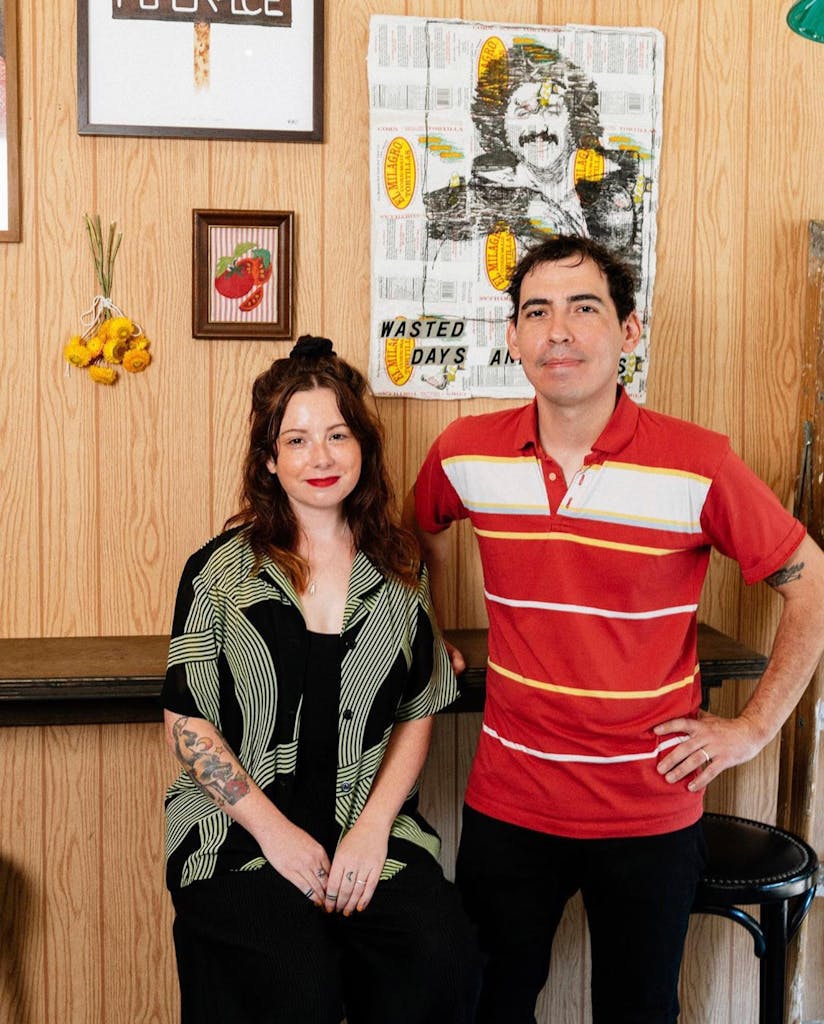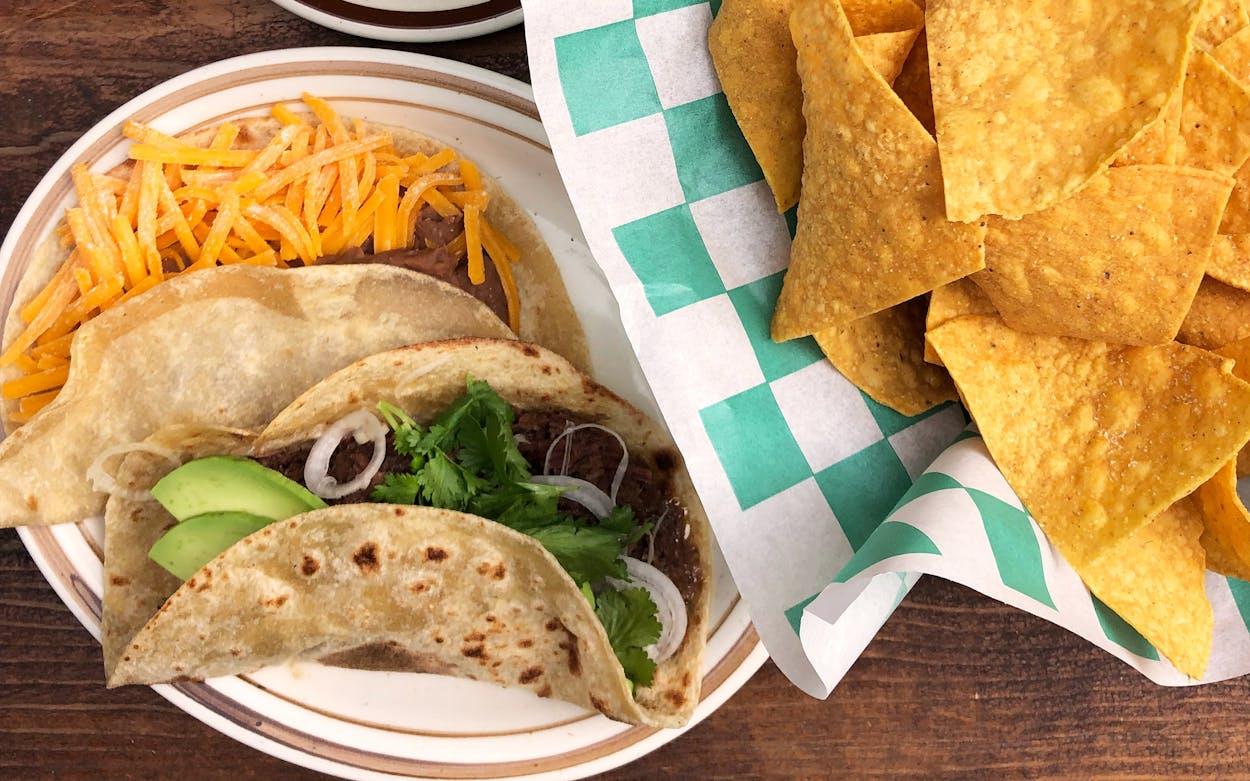There comes a moment in every Texpat’s life when the food from home calls: the subtle dust from a floury tortilla, the irresistible cheesiness of a breakfast taco, the enduring sweetness of a Texas sheet cake. Some far-flung restaurants try to capture the nostalgia with gimmicks such as walls covered in cowboy hats, or parodies of our famously large servings. But one relatively new restaurant in New York City pays updated homage to the culinary diversity of South Texas, offering respite for displaced natives of the state and yet another excursion for New Yorkers curious about exotic cultures.
Yellow Rose, owned by San Antonio natives Dave and Krystiana Rizo, has introduced the cuisine the couple grew up with to Manhattan’s East Village, a neighborhood known for its formerly gritty bars and rising rents. The couple moved to New York, which Dave Rizo considered “the holy grail” of cooking, in 2017. While working at prominent restaurants such as Superiority Burger and Emmy Squared, they found their professional success was tempered by intense bouts of homesickness. So they set out to bring a bit of home to the city, crafting Yellow Rose taqueria pop-ups, and then opening the brick-and-mortar restaurant last November.
“There was just no food that you could get back home up in New York,” says Dave Rizo. He and his wife have worked to create a restaurant that highlights the range of South Texas cooking, which Rizo, a Mexican American, prefers not be categorized as Tex-Mex. As a native Houstonian who’s made New York my second home, and who loves Tex-Mex, I found the Rizos’ food something else altogether.

The surprisingly spacious—for New York—restaurant resembled some of my favorite places from undergraduate days at the University of Houston. Uneven photos hung along the floral, papered walls, showcasing famous Texans and those stunning, serene West Texas windmills. Topo Chico bottles filled with dried yellow roses provided a charming Texan welcome.
Our starter dish of vegan queso was perhaps the most impressive part of the meal. Though Texas restaurants are slowly introducing vegan cheeses and other options free of animal products, vegan queso is rarely a highly sought-after dish among carnivores in either of my home states. Here, nearly every table sported an order, and after just one chip, we understood why. The cashew-based dip packed real depth, using the cashews for body and texture more than flavor. The pickled peppers checkered across the ancho chile oil pierced the queso with a subtle sweetness.
A white-bean chalupa offered a fresh take on that fried dish. Topped with a rotating array of mixed vegetables—tomatoes and corn on this particular night—and Rancho Gordo Alubia Blanca beans, the fried tortilla had a deep crunchiness punctuated by cobanero hot sauce. The barbacoa taco and bean and cheese taco were of a heft rarely seen in New York’s often bite-size versions of those dishes. The homemade tortillas were thick, warm, and perfectly doughy. The barbacoa was plump and tender—signs of a patiently simmered pot of beef cheeks—and touched gently with onions and cilantro. A papas ranchera taco, filled with potatoes bathed in ranchero salsa, provided yet another masterful, perfectly seasoned vegan dish.
“I feel like sometimes with restaurants that serve meat, the vegetables get put in the back seat a little bit, and that’s not the case here,” Rizo says. “We think about the vegetables just as intensely as you would a meat preparation.”
That’s not to say the Rizos devalue their meat dishes. For their Lengua Torta, for example, they brine cured beef tongues with bushels of dried chiles, air-drying the tongues for several days, smoking and slow-roasting for several hours, and then crafting the final sandwich.
Like many chefs, Rizo arrived at cooking in a roundabout way, unsure of what exactly he wanted to do with his life. Growing up in San Antonio’s West Side in a historically Mexican American neighborhood, Rizo remembers a time when speaking Spanish in school was strongly discouraged, so much so that he can barely speak the language today. Once he found his culinary craft, however, his Mexican heritage guided him. “The West Side of San Antonio, it’s strong in culture, in art, and in food,” he says. “It’s a very proud neighborhood, but also one of the poorest neighborhoods, not only in San Antonio, but in all of Texas. A little bit of this was trying to come up here and bring that West Side pride and Chicano pride and show them that we can do really amazing things with what we have.”
The Rizos source ingredients from both their home state and local providers: pecans from Texas for their sheet cake, Sonoran flour, produce from nearby farmers’ markets, and local New York honey.
For Texpats in New York, many of whom proudly identify themselves to the staff, Yellow Rose has managed to capture the Lone Star State culture without becoming a caricature. And for New Yorkers, many of whom are new to Texas cuisine, Yellow Rose provides an authentic entry point.
- More About:
- Restaurant Reviews
- New York City






